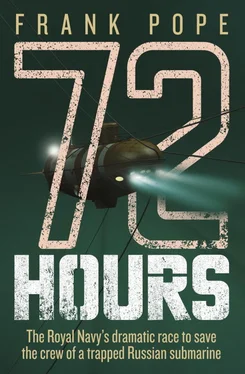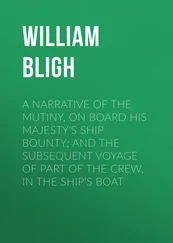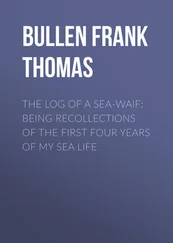The next few years saw him working in a number of different shore jobs, trying to work out which way he should go next. He had become a ‘shiny-arsed inboard bastard’, as they put it in the Navy. He wouldn’t get to command a submarine, and he was certain he’d never make the rank of Commander. Then, out of the blue, a promotion signal came through with his name on it. He’d be Commander – in rank at least – after all. When he was summoned to see his ‘Appointer’ two months later, he was presented the list of jobs for which he was being considered. It wasn’t long. There was one position: Submarine Escape and Rescue Equipment Manager at Abbey Wood on the outskirts of Bristol, starting in December 2003.
It was some consolation, but he knew he was now destined to roam the back-alleys of the Ministry of Defence for the rest of his Naval career. He kn ew he’d always be a submariner and would still wear the dolphins with pride, but he’d never be back at sea in a submarine in an operational role, doing what he did best.
Thursday, 4 August
16.30 Kamchatka
AS-28 , 210 metres beneath Berezovya Bay
Captain Lepetyukha’s first thought was to keep everyone calm. There were some young, inexperienced sailors on board, and there was no sense in panicking them. They may have just reversed into a piece of free-floating net, or the process of entanglement may have torn it free, after all. But there was a good chance that whatever had tangled the propeller was connected to the array. Unfortunately, without a stern light there was no way they could check. He decided not to make a report to the Georgy Kozmin just yet. In the Russian Navy, all else being equal, it was better to do what you could by yourself first before passing on bad news.
He ordered Milachevsky to make a thorough scan around the submersible while he had a muttered conversation with Bolonin over how best to proceed. When the lieutenant finished his inspection he reported the first rope was still there on the bow, and there now seemed to be another snagged beside one of the dome bolts. Though the young pilot was doing his best to disguise it, there was a hint of fear in his voice.
‘We will use our positioning thrusters to move laterally,’ Lepetyukha barked. If the cables were not snagged too tightly on the array, moving in a different direction might set them free.
The higher-pitched whine of the smaller positioning thrusters, mounted on both the stern and the bow, slowly filled the spherical steel chambers of AS-28. The craft began to ease away from the array, the cables scraping their barnacles against the hull. They’d managed to get a couple of metres’ clearance when their momentum started to slow.
‘Maximum power!’ ordered Lepetyukha, but to no avail. The motors began to strain, and AS-28 was no longer moving. ‘All stop,’ he snapped. As the sound of the motors died away, the swirling starfield of floodlit particles in the porthole began to shift to the left, then the hull jolted with a hollow metallic boom. AS-28 had been drawn back against the array in the net’s lethal embrace.
Only one direction was left open to him, the same direction that each crew member’s mind was starting to reach towards. The surface. Blowing the ballast tanks would make the submersible lighter, launching it upwards. The time had now come to inform the Georgy Kozmin on the surface. The captain picked up the underwater telephone and gave a short, factual report outlining their position and measures attempted so far. Trying to send voice as high-frequency sound through the water made for frequent distortion, but with the Kozmin only 200 metres above them the apparatus was working fairly well. After giving his status report, Captain Lepetyukha stated that he was about to blow the ballast tanks in an effort to float free of the entanglement, and would make a new report once he’d carried out the manoeuvre.
Bolonin coughed, and all eyes turned to him. The clock had begun to tick, but the engineer had been in many a tight situation underwater, and knew that what would kill them most easily would be rushed decisions. He was all too aware of the lack of backup available. He felt like an ambitious mountaineer who’d been too focused on the summit ahead, and not paid enough attention to how they’d get down if something went wrong. Now they were in trouble and there was no one nearby with equipment that could help them.
Blowing the tanks came with risks beyond simply tightening the bonds that held them to the seabed. If one of the lines – perhaps the one wrapped around the propeller – held fast, they could quickly find themselves tilting off balance. Beyond a certain angle the acid would start leaking from the bank of batteries, creating acrid and poisonous chlorine gas that would rapidly choke them. Floating up was still the best option open to them, but it must be done with extreme caution. After explaining his concern, Bolonin nodded to the Captain, who gave the order.
Compressed air started exploding into the two ballast tanks that flanked the AS-28 ’s hull, pushing the seawater out of a valve at the bottom at a pressure of between 3,500 and 4,500 pounds per square inch. The surrounding seawater transmitted the sound perfectly, while the curved shape of the hull amplified it until it sounded like an express train passing a platform at full speed. Despite its deafening volume, the sound was a comforting one. Submariners have an intimate relationship with their buoyancy, for their craft are perpetually on the edge of sinking. The roar was not just the noise of returning to the surface, but also the sound of everyday routine. Even at the dockside, submarines blow out each of their tanks once a day to make sure they are correctly trimmed.
The cables lying over the submersible’s nose began to tighten as she rose. Like the rest of the crew, Milachevsky gripped secure handholds. With no frame of reference except the tiny portholes in the bow, all but Bolonin darted their eyes about the cylindrical walls of the inside hull as though looking for clues as to what was about to happen. Then a sudden lurch sent loose items crashing to the deck as the stern slipped upwards a few feet but stopped again just as suddenly. Something was holding them – another cable had become wrapped behind the main fin. The tilt indicators showed they were already 13 degrees off level. Any more and they risked flipping the craft into a vertical position or on its side, and releasing the battery acid. Like a fly’s attempts to escape a spider’s web, the manoeuvring had served only to entrap the submersible more tightly. There was now no way they would be able to escape by themselves.
Thursday, 4 August
SS + 30 mins
17.00 Kamchatka
Russian Federation Navy Vessel Georgy Kozmin , Berezovya Bay
On the surface, Captain Novikov was struggling to find workable options for a rescue. Seven of the sailors under his command were trapped on the seabed, and every minute now was precious. Procedures would have him launch the second Priz submersible, AS-29 , but it was sitting on the dockside in Petropavlovsk. It had been plundered for spares, and there was no way it could be rendered operational any time in the next week, even if all the parts were immediately available and the engineers weren’t on holiday.
There was another Priz class rescue submersible in Vladi vostok to the south, but despite being part of the same Pacific fleet, there was almost no functional connection between Primorye and Kamchatka when it came to the Navy. The distances were too large. It was part of the same problem that had plagued the Russian Navy since its inception – fleets defending the Black Sea, the Baltic, the north, and the Pacific were forced to operate in isolation from one another. The nearest functional Russian rescue submersible was four and a half days’ sailing away.
Читать дальше












